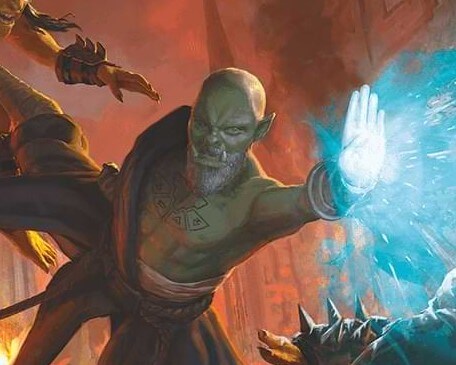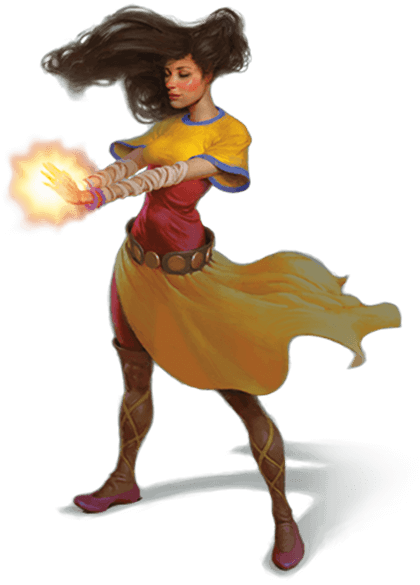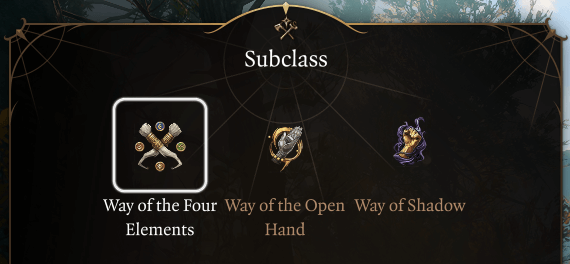Everything You Should Know About the Baldur’s Gate 3 Monk and its Subclasses
Masters of Ki, and channeling their inner enlightenment, the Baldur’s Gate 3 Monk specializes in close-quarters combat and moving around the battlefield freely.
Whether that means fighting honorably with the Way of the Open Hand, lurking in the shadows with the Way of Shadow, or mastering the elements to your will with the Way of the Four Elements – the choice is yours.
Monks focus on building their Dexterity to be as nimble as possible, while also training their mind’s Wisdom through their life and spiritual experiences.
So dexterous has the Monk become, their reflexes have become their shields as their Wisdom Modifier is added to their Armor Class while not wearing armor.
Likewise, Monks have trained themselves to become so versatile, they can rely on Dexterity or Strength for their attacks, depending on whichever is higher.

They have the capability to dish out tons of damage, while still being able to stand their own ground. Monks also greatly excel at crowd control, from Stunning Strike to Water Whip and Flurry of Blows, the enemy won’t be left with a lot of room to strike back. In this guide, we will explain all the ways to play this simple, yet very effective class.
Find out where the Monk ranks in our Baldur’s Gate 3 class tier list.
Pros and Cons
![]()
Pros
- With the ability to refresh their Ki on just a Short Rest, Monks thrive in being able to punch their way through numerous battles before it’s time to hit camp.
- There is an abundance of gear in the game that boosts unarmed strike effects, such as adding damage or even restoring your health on each attack. This is especially strong since Flurry of Blows allows you two extra unarmed strikes right from character creation.
- Monks are some of the most mobile classes you can pick from; with extra movement speed, and eventual longer jump range while not being affected by Difficult Terrain – they are able to quickly and effectively dart around the battlefield.
Cons
- Lacks the raw damage output of some of the other melee choices, especially compared to its ‘unarmored’ counterpart; the Barbarian.
- The lack of armor makes Monk fairly squishy in the early game when charging into danger, and they have little ranged options to work with.
- Monks will typically lack heavily in CHA and INT, making your character an effective dumbbell when it comes to interacting with people.

Monk Mechanics
Focusing on channeling their inner Ki, Monks devote their life to seeking Balance. Monks strive to help others find peace among many benign situations, but don’t underestimate the Monk – for when pushed to the edge, Monks become a lethal weapon without the need for steel or iron.
The Monk is given many unique dialogue options revolving around centering yourself, becoming at peace with death, or settling arguments without the need to fight. This way of life is then expanded on with how the Monk chooses to devote themselves to their Ki, from the silent assassin led by the Way of Shadow, or a venerable enforcer with the Way of the Open Hand.
The main strength of the Monk comes from their ability to maneuver quickly around the map, from target to target. Monks have a higher base movement speed thanks to the Unarmored Movement feature, this paired with the ability to launch multiple attacks in one turn can make them quite the threat.
When compared to other melee classes, Monks are unique in that they do not use weapons, and instead focus their abilities on unarmed combat, being given an extra strike after attacking with their bare hands. Monks fit a happy medium between pure damage output and ability to remain bolstered on the frontline.
Having spent many of their early years in the monasteries, Monks have not only sharpened their bodies, but also their minds. Allies will look to their Monks to settle disputes, and to provide unique Insight in certain situations, especially coming to History or Religion. Monks excel at their Athletics and Acrobatics abilities. Certain monks who have dedicated themselves to the shadows show prowess in Stealth or Sleight of Hand.
Starting at level three, players are given the opportunity to focus on how to hone their Ki – Whether they choose the Way of the Four Elements, the Way of the Open Hand, or the Way of the Shadow is completely up to them. Each subclass will focus on a different ‘type’ of Monk, based on how the character wants to play, or how they feel it fits best into the character’s archetype they are building.
Ki Points Resource
Ki is the life-force of every living being, and what Monks strive to master their control of.
Monks gain 2 Ki Points at level 1, and an additional Ki Point for every additional level put into Monk. Ki Points are fully recharged on Short Rests.
The Monk can expend his Ki points for a variety of different actions and attacks, with even more capabilities being given when the Monk picks a subclass (explained later on).
| Level | Feature | Description |
|---|---|---|
| 1 | Flurry of Blows | Punch twice in quick succession |
| 2 | Patient Defense | Attack Rolls against you have Disadvantage, and you have Advantage on Dexterity Saving Throws |
| 2 | Step of the Wind: Dash | Double your movement speed. Jump no longer requires a bonus action |
| 2 | Step of the Wind: Disengage | Retreat to safety by Disengaging. Jump no longer requires a bonus action. |
| 3 | Deflect Missiles | Use your reaction to reduce the damage from a ranged weapon attack by 1d10+ your Dexterity Modifier + your monk level. If the damage is reduced to 0, you use a Ki Point to Deflect the missile. |
| 5 | Stunning Strike (Melee) | Possibly Stuns the target |
| 5 | Stunning Strike (Melee) | Possibly Stuns the target |
Main Class Signature Features
Outside of Ki, monks are given an abundance of additional features that help sculpt them into the formidable machine of constant punches and crowd control they can be.
| Level | Feature | Description |
|---|---|---|
| 1 | Unarmored Defence | While not wearing armor, you add your Wisdom Modifier to your Armour Class. |
| 1 | Martial Arts: Dextrous Attacks | Attacks with Monk Weapons and unarmed attacks scale with your Dexterity instead of your Strength if your Dexterity is higher. |
| 1 | Martial Arts: Deft Strikes | Attacks with Monk Weapons and unarmed attacks deal 1~4 Bludgeoning damage, unless their normal damage is higher. |
| 1 | Martial Arts: Bonus Unarmed Strike | After making an attack with a Monk Weapon or while unarmed, you can make another unarmed attack as a bonus action. |
| 2 | Unarmored Movement | Your movement speed increases by 3m while you are not wearing armor or using a shield. |
| 3 | Deflect Missiles | Use your reaction to reduce the damage from a ranged weapon attack by 1d10+ your Dexterity Modifier + your monk level. If the damage is reduced to 0, you use a Ki Point to Deflect the missile. |
| 4 | Slow Fall | When you fall, you can use your reaction to gain Resistance to Falling damage. |
| 5 | Extra Attack | Can make an additional free attack after making an unarmed or weapon attack. |
| 6 | Improved Unarmoured Movement | Your movement speed increases by 4.5m while you are not wearing armor or using a shield. |
| 6 | Ki-Empowered Strikes | Your unarmed attacks count as magical for the purpose of overcoming enemies’ Resistance and Immunity to non-magical damage. |
| 7 | Evasion | Your agility lets you dodge out of the way of certain spells. When a spell or effect would deal half damage on a successful Dexterity Saving Throw, it deals no damage if you succeed, and only half damage if you fail. |
| 7 | Stillness of Mind | If you are Charmed or Frightened, you automatically cast Stillness of Mind to remove the condition. |
| 9 | Advanced Unarmoured Movement | Difficult Terrain doesn’t slow you down and you can Jump an additional 6m while you are not wearing armor or using a shield. |
| 10 | Purity of Body | You are Immune to Poison damage and can’t be Poisoned or affected by disease thanks to the purifying ki flower through your meridians. |

There are three subclasses for Monks in Baldur’s Gate 3. Each subclass is flavored as a different Way of studying Ki that they will discipline themselves in.
Every Monk gains a plethora of abilities as they level up, such as Step of the Wind, to help them dash and disengage around the map, as well as Stunning Strike to seize up your opponents.
Each Way of study provides an alternate playstyle to expend their Ki points that the Monk gains as they level up.
- Way of the Four Elements
- Way of the Open Hand
- Way of Shadow
Monk Subclasses
Way of the Four Elements
| Level | Feature | Description |
|---|---|---|
| 3 | Disciple of the Elements | You can use Ki to power magic that harnesses the elements. These spells also trigger Unarmed Strike. |
| 3 | Harmony of Fire and Water | While not in combat, regain half your Ki point Points (rounded down). |
| 6 | Disciple of the Elements | Gain a Spell |
| 9 | Disciple of the Elements | Gain a Spell |
| 9 | Improved Elemental Casting | Your affinity with elemental Ki deepens. Several of your offensive Four Elements features deal an additional dice of damage, your Clench of the North Wind can hold an additional creature, and your Embrace of the Inferno fires an extra ray. |
| 11 | Disciple of the Elements | Gain a Spell |
You focus your ki to bend the elements to your will, using them as an extension of your own body.
The Way of the Four Elements has the Monk striving to gain mastery over earth, wind, water and fire. Select spells that the Monk can spend their Ki on, from empowering your melee attacks with fire – to gliding on the wind currents itself. This is the most Ki-dependent subclass, but it pays off in droves.
Overall, The Way of the Four Elements is the perfect subclass for the Monk who is looking to add a little utility in their kit, as well as those who consider themselves among the arcanely gifted.
Way of the Open Hand
| Level | Feature | Description |
|---|---|---|
| 3 | Punch twice in quick succession and possibly knock the target prone. | Punch twice in quick succession and possibly knock the target prone. |
| 3 | Punch twice in quick succession and Stagger the target, making it unable to take reactions. | Punch twice in quick succession and Stagger the target, making it unable to take reactions. |
| 3 | Flurry of Blows: Push | Punch twice in quick succession and possibly push the target 5m away. |
| 6 | Manifestation of Body | Your hands sap the Ki from your enemies’ bodies. Your unarmed attacks deal an additional 1-4 + WIS modifier Necrotic damage. |
| 6 | Manifestation of Mind | Your strikes interrupt the Ki flow to your enemies’ minds. Your unarmed attacks deal an additional 1-4 + WIS modifier Psychic damage. |
| 6 | Manifestation of Soul | Infuse your strikes with Ki from outside your body. Your unarmed attacks deal an additional 1-4 + WIS modifier Radiant damage. |
| 6 | Wholeness of Body | 18 Healing. Regain half your Ki Points and enter a temporary state of Wholeness where you can regain Ki points and have an extra bonus action. |
| 9 | Ki Resonation: Punch | Hit a creature with your bare fists, making the Ki in its body Resonate with yours. You can then make the Ki explode with Ki Resonation: Blast |
| 9 | Ki Resonation: Punch (Bonus Action) | Hit a creature with your bare fists, making the Ki in its body Resonate with yours. You can then make the Ki explode with Ki Resonation: Blast |
| 9 | Ki Resonation: Blast | Detonate the Ki of a creature Resonating with you, hitting the creature and anyone within 5m of it. |
| 11 | Tranquility | Long Rests surround you with an aura of peace, granting you Sanctuary. |
You specialize in unarmed combat, using your hands and your control of Ki to heal or inflict grievous hurt.
Monks who train themselves in the Way of the Open Hand are those who are determined to make their body itself the strongest weapon. Stacking on additional damage with the different Manifestation features, remember you can perform multiple unarmed strikes per turn to really pile up the hurt.
The Way of the Open Hand Monks can even detonate the Ki of other creatures, using your own sheer control over Ki. This is the most offensive Monk subclass you can choose.
Way of Shadow
| Level | Feature | Description |
|---|---|---|
| 3 | Minor Illusion | Create an illusion that compels nearby creatures to investigate. |
| 3 | Shadow Arts: Hide | Hide from enemies by succeeding Stealth checks. Stick to the dark and avoid enemy sightlines. Attacking or casting a spell will reveal your location. |
| 3 | Shadow Arts: Pass Without Trace | Call forth a veil of shadows and silence that gives you and all nearby companions a +10 bonus to Stealth Checks. |
| 3 | Shadow Arts: Darkness | Create a dark shroud that heavily Obscures and Blinds creatures within. Creatures cannot make ranged attacks into or out of it. |
| 3 | Shadow Arts: Darkvision | Grant a creature the ability to see in the dark out to a range of 12m. |
| 3 | Shadow Arts: Silence | Create a sound-proof sphere. All within are Silenced and Immune to Thunder damage |
| 5 | Wholeness of Body | Wrap yourself in shadows to become Invisible if you are obscured |
| 6 | Shadow Step | Teleport from shadow to shadow. Afterwards, you have Advantage on your next melee Attack Roll. |
| 11 | Shadow Strike | Teleport to a foe from a hidden position, striking them with the creeping, psychic ferocity of the shadows themselves. |
| 11 | Shadow Strike: Unarmed | Teleport to a foe from a hidden position, striking them with the creeping, psychic ferocity of the shadows themselves |
You value the arts of stealth and subterfuge, bending the shadows to your will to strike without warning.
The Way of the Shadow is the closest a Monk will get to playing like a ninja. Striking from the shadows and blinking around the map, the Monk who trains in the Shadow will become the deadliest thing the enemies never saw coming.
Even if there is nowhere to hide, the Way of the Shadow Monk can create their own cover using Shadow Arts: Darkness, and give themselves and their allies the ability to see through it. Players should consider this subclass if they yearn for stealth as well as quick, painful strikes while darting around the map
So which Monk subclass should you play?
For players who enjoy the concept of a ‘spellblade’ type class, but the ‘blade’ is your bare hands. If you want to master the elements and add utility into your kit, pick The Way of the Four Elements.
If brute melee force is your appeal, but you want more utility and crowd control than Barbarian, pick The Way of the Open Hand.
For the players who love the appeal of stealthy gameplay, but would rather a more durable frontliner than the Rogue. If you want stealthier gameplay and to strike powerfully from the shadows, pick The Way of Shadow.
So that’s it! As always, please remember that you can easily respec your character any time for just 100g at Withers, so feel free to try out every Monk subclass and see which works best for you!
 Download APP
Download APP